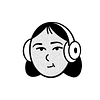You need to sign in or sign up before continuing.
Take a photo of a barcode or cover
What can I say? This was one of the best books I've read in a while. Of course, I'll never forgive it for completely ruining any chance I'd ever have to simply enjoy a sign on a shop or a book cover or a restaurant menu, or any written item I chance to see around me. I can never go back to simply "reading" the title, instead I examine the font and wonder what subliminal message it conveys (and more often than not, the shop owner or movie poster designer might not even imagine what their choice of font reveals). I guess I'm a type geek, probably I always was, and I truly enjoy fiddling with all the different typefaces our modern age offers us. Gaining some insight about the inner workings of this sphere was really eye opening - better late than never, I suppose.
The author has a wonderful writing style that I thoroughly enjoyed - which cannot be said about the narrator of the audio book, to whom I owe my deepest gratitude for forcing me to read the actual book, and SEEING all the types mentioned in it. I wonder what possessed me to think I could simply get the audio version.
Highly recommended to anyone who's even remotely interested in the subject.
The author has a wonderful writing style that I thoroughly enjoyed - which cannot be said about the narrator of the audio book, to whom I owe my deepest gratitude for forcing me to read the actual book, and SEEING all the types mentioned in it. I wonder what possessed me to think I could simply get the audio version.
Highly recommended to anyone who's even remotely interested in the subject.
Best for:
Those who enjoy a bit of trivia about common things; those interested in graphic design.
In a nutshell:
A history of fonts, with a focus on some of the better-known ones.
Worth quoting:
“If all letters were exactly the same height they wouldn’t appear so: round and pointed letters would appear shorter.”
“They established that it is a lot easier to read lower-case letters than capitals when travelling at speed.”
Why I chose it:
I love this kind of shit.
Review:
There’s not a ton I can say about this book that isn’t just be sharing interesting trivia I learned. Like, as referenced above, researchers have determined that it’s better to put location names on roadsigns with upper case starts followed by lower case letters. It’s because one looks for the shape of the word, not the individual letters. And so can spot the shape they’re looking for before they can read the word.
Do you find that nugget of information interesting? Then this book is for you.
Author Garfield takes us on a trip that isn’t so much chronological as focused on subject areas. He shares the history of some well-known fonts (starting with Comic Sans!) and why they come to be. He also looks at issues like: do fonts have a gender? A nationality? Do they evoke a time period to you?
He also shares some of the more technical things about fonts. For example, what makes a font easier to read online makes it more difficult to read on paper and vice versa. Which is super annoying for me in my work, as I produce many documents that need to be readable in both formats.
This is a fairly niche book but it’s also accessible. If you’re looking for a gift for someone who you think might enjoy this type of thing, they probably will like this one.
Keep it / Pass to a Friend / Donate it / Toss it:
Donate it.
Those who enjoy a bit of trivia about common things; those interested in graphic design.
In a nutshell:
A history of fonts, with a focus on some of the better-known ones.
Worth quoting:
“If all letters were exactly the same height they wouldn’t appear so: round and pointed letters would appear shorter.”
“They established that it is a lot easier to read lower-case letters than capitals when travelling at speed.”
Why I chose it:
I love this kind of shit.
Review:
There’s not a ton I can say about this book that isn’t just be sharing interesting trivia I learned. Like, as referenced above, researchers have determined that it’s better to put location names on roadsigns with upper case starts followed by lower case letters. It’s because one looks for the shape of the word, not the individual letters. And so can spot the shape they’re looking for before they can read the word.
Do you find that nugget of information interesting? Then this book is for you.
Author Garfield takes us on a trip that isn’t so much chronological as focused on subject areas. He shares the history of some well-known fonts (starting with Comic Sans!) and why they come to be. He also looks at issues like: do fonts have a gender? A nationality? Do they evoke a time period to you?
He also shares some of the more technical things about fonts. For example, what makes a font easier to read online makes it more difficult to read on paper and vice versa. Which is super annoying for me in my work, as I produce many documents that need to be readable in both formats.
This is a fairly niche book but it’s also accessible. If you’re looking for a gift for someone who you think might enjoy this type of thing, they probably will like this one.
Keep it / Pass to a Friend / Donate it / Toss it:
Donate it.
This is such a beautiful book about such a niche topic. This is what I want out of everything I label "subject study": a deep read that truly understands its topic as a mirror to the best and most interesting parts of humanity. Poetic, grand, and thoroughly researched, I don't know what else I could want.
An engaging overview for the type-curious (probably too basic for anyone who really knows a lot about typography), with what amount to biographical sketches of different typefaces and their adventures in the world of print, as well as profiles of type designers. Book design geeks will enjoy Chip Kidd's introduction about his own relationship with typography, which includes a reproduction of a much-drawn-on school notebook cover with his favorite bands' logos.
informative
medium-paced
informative
reflective
fast-paced
5th booktubeathon read. Liked this book as a whole but was a lot of use of terminology that was unfamiliar to me. Even in the section they were explaining terms it was hard to comprehend. The use of photos when explaining the terms would of helped the understanding.
informative
inspiring
From how one of the world's ubiquitous and detested fonts—Comic Sans—got invented to how Ikea caused controversy by switching from Futura to Verdana, Garfield has put together a fascinating and entertaining book. Some chapters are more interesting than others. But overall, this is a must read for anyone with an interest in design and typography.
funny
informative
lighthearted
reflective
relaxing
fast-paced
I had never given fonts much thought before, aside from my hatred of Comic Sans and unwilling love of Calibri. Now I notice typefaces everywhere, especially in advertising and public transit signage. And I have a new appreciation the lower case g.
Coincidentally, this makes a nice companion to "Mr. Penumbra's 24-Hour Bookstore" -- that novel's typography storyline is more interesting to me now, in hindsight.
Coincidentally, this makes a nice companion to "Mr. Penumbra's 24-Hour Bookstore" -- that novel's typography storyline is more interesting to me now, in hindsight.








